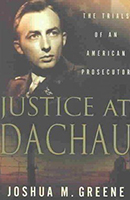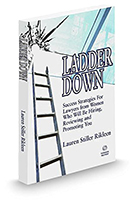 Verdict: Touchdown!
Verdict: Touchdown!
Justice at Dachau: The Trials of an American Prosecutor
By Joshua M. Greene (Chicago, IL: Ankerwycke, 2016). 392 pgs. $17.95/$13.55 (ABA members). Order, shop.americanbar.org.
Reviewed by Craig R. Johnson
Justice at Dachau: The Trials of an American Prosecutor, by Joshua M. Greene, is the story of what might be called “the other war crimes trials” – those that involved not the Nazi high command who designed and planned the final solution and who were tried at Nuremburg, but rather the camp officials, guards, and SS soldiers who carried out the daily horrors.
The book recounts the military service of U.S. Army prosecutor William Denson, who aassembled a team to bring to justice the guards and camp staff who ran the Dachau, Mauthausen, and Buchenwald camps during World War II. Greene tells how Denson chose the dozens of Nazi defendants to bring to trial, developed a legal strategy, and marshaled the witnesses and documentary evidence necessary to win convictions before military tribunals throughout 1946 and 1947.
Denson was in charge of three major trials, each involving dozens of defendants from first Dachau, then Mauthausen and finally, Buchenwald. The book focuses not only on the trials themselves but also on the personal lives of Denson and the other military personnel involved in them.
The details about the prosecution theory of “common design,” akin to conspiracy law, as well as the due process rights afforded the Nazi defendants, are fascinating. For example, before the Dachau trial, the defendants were offered the chance to choose their own defense counsel, paid for by the U.S. Army. While ultimately the majority of the defense team consisted of U.S. Army lawyers, there was at least one German attorney as well (ironically, a former Nazi who had defied the regime and had ended up in Dachau as a prisoner himself. Nonetheless, he was chosen by the defendants to help them).
Want to Review a Book?
Please request a book and writing guidelines from Wisconsin Lawyer managing editor Karlé Lester, at klester@wisbar.org or (608) 250-6127. Reviewers may keep the book reviewed. Reviews of about 500 words are due within 45 days of receiving the book. Reviews are published, space permitting, in the order received and may be edited for length and clarity.
The army lawyers who defended the camp guards and lower-level staff took their responsibility seriously and fought hard against what they considered the overreach and lack of specificity of the charges issued by the prosecution. That the defendants received such a vigorous defense from the same army that marched into the camps at the end of the war and witnessed some of the most unspeakable conditions imaginable is admirable.
Denson’s record of success is well chronicled, as are later, disheartening developments regarding some of the Nazis he fought so hard to convict, including the lone woman defendant, Ilse Koch, whose sadistic tendencies received broad press attention at the time and merit their own chapter in the book. After 1948, with the reintegration of Germany into Western Europe an increasing priority, many of the former defendants, including Koch, had their sentences reduced and were released. (Koch herself was promptly retried by German authorities and spent the rest of her life in prison.)
Denson was rankled by the second-guessing of the hard-won results he had achieved; the last section of the book details his fight against the shameful backsliding of the authorities as they caved in to pressure to “move past” the war crimes trials that brought a small measure of justice to the many millions of victims.
Craig R. Johnson, U.W. 1994, practices criminal defense and labor law at Sweet and Associates, Milwaukee.
 Verdict: Not for Me, Maybe for You
Verdict: Not for Me, Maybe for You
Ladder Down: Success Strategies for Lawyers from Women Who will be Hiring, Reviewing and Promoting You
By Lauren Stiller Rikleen (Eagan, MN: Thomson West 2016). 276 pgs. $17.96. Order, legalsolutions.thomsonreuters.com.
Reviewed by Lori S. Kornblum
This book’s title leads the reader to believe it is a guide to success for young women lawyers. Unfortunately, it is not. It is a collection of advice from women who climbed to the top of private law firms. This advice often conflicts. The author does not distill any coherent strategy, but leaves the reader to puzzle out how to take the information and apply it to her own career. The author strings together contributor stories, arranged topically but without much editorial content.
The two most useful parts of the book are the chapter on how to prepare for annual and salary reviews (because the advice is consistent and practical) and the chapter on mentoring. While presenting the universal advice that young lawyers must find and use mentors, the author presents data that mentors are not effective for women. Women tend to view mentors as sounding boards for career advice, while men tend to view mentors as “champions,” who will assist their mentees in moving up the ladder. Thus, women must find “champions” rather than mentors.
Information from the remaining parts of the book is confusing, contradictory, and discouraging.
What does the ladder require? First and foremost, as the author and all contributors acknowledge, is many billable hours.
Then, a woman must be a leader, not only in her own law firm, but in the community and the bar. The possibility of climbing the ladder without becoming a leader is nonexistent. The contributors also mention, but downplay, the reality that engaging in leadership activities will not lead to immediate success, because often law firms do not appreciate women becoming leaders and may discourage leadership in all but administrative roles.
Young women must also distinguish themselves by developing “niche” practices. How to do this? Depends who you ask. Follow your passion? Don’t follow your passion. Create opportunities? No, jump on opportunities presented. Develop a new field of law? No, this may become obsolete. Above all, be flexible, such as living in another country apart from your spouse for seven years.
While the young lawyer is doing all of the above, somehow she is finding work-life balance and never misses a ballet recital or soccer game. Perhaps that is possible for the super-lawyer-type contributors, but hard to fathom for the average human being just enjoying being a professional.
Against this background, and perhaps as a result of it, the book also devotes substantial space to urging the legal profession to change so that women can be successful in the profession. To find this information, read chapter 1, the two appendices, and the last parts of most chapters.
Perhaps the best audience for the book would be young lawyers and law students who are seeking careers in the world described in this book. At least they would know what they face. And, if they should happen to land an interview with one of the contributors, at least the interviewee will know what that particular contributor thinks is the key to climbing the ladder.
Lori S. Kornblum, Berkeley 1982, is a full-time faculty member at Milwaukee Area Technical College, Department of Paralegal Studies; an adjunct faculty member at Marquette University Law School; and in private practice focusing on child abuse and neglect, private termination of parental rights, adult guardianship, and disability issues.
 Verdict: It’s a Keeper
Verdict: It’s a Keeper
Big Fracking Mess
By Lee Atterbury (Middleton, WI: Self-published, 2016). 316 pgs. $12.99. Order, www.amazon.com.
Reviewed by Dan Graff
Big Fracking Mess is a heckuva thrilling story. Set in the Bighorn Mountains of Flint County, Wyo., it captures many angles of the mountain West. It features an unlikely partnership of two deputy sheriffs, the protagonist James “Jim” Taylor, a man of baby boomer age and values, and Amy Hooker, usually known as “Hook,” a much younger Army veteran, who in most things goes a lot more by the book. Jim and Hook come into a very unusual and exciting law enforcement assignment featuring deadly assaults and environmental crimes. They have to bring to justice some pretty mean and bad guys, with even meaner, badder backers.
Another unusual partnership is between Jim Taylor and his horse, Buck. The author clearly knows and loves riding and communicating with horses. Jim and the horse Buck do a lot of both over the course of the book. I particularly enjoyed Atterbury’s writing of these adventures from Buck’s perspective, which rang true and showed incisive insight into what the horse smelled, saw, heard, and felt and on those bases communicated and acted. I’ll think about this perspective next time I see a horse in a field or farmyard in rural Wisconsin. The descriptions of riding, hiking, and camping in the mountains of Wyoming also rang true and really evoked the sights, sounds, and smells of this high and beautiful country.
The book involves a whirlwind of back-country chases, fights, and escapes of Jim and Hook, with their friends and allies. Deputies Jim and Hook start out together, go separate ways, and eventually come back together for the book’s final confrontation. You learn a lot about the strengths, peculiarities, and personal preferences of Jim, Hook, and their friends. The reading is easy, and the pace of action is unflagging.
The book is by no means a law-related story. The most legal it gets is in tangential discussions of how law enforcement and evidentiary concerns can influence the sheriff’s deputies’ and state troopers’ interviews and information gathering, political pressure by an attorney general on a county sheriff, and a relatively minor federal court decision in the book enjoining a fictitious Data Trespass Act.
Readers should also be aware that the book does involve some very violent scenes and gunplay. However, most detective and adventure stories cover this kind of rough terrain. Big Fracking Mess does so in an entertaining way with some unusual viewpoints and relationships, and well-evoked scenes. It will keep you entertained and turning the pages. And the plot does include a fracking operation, so the title is merited. Fans of the genre should know Wisconsin lawyer Lee Atterbury has written three other Jim and Buck novels, and another is in the works.
Dan Graff, U.W. 1994, is a lawyer in Madison. Before law school he was a geologist, and once worked in Montana close to the Bighorn Mountains where Big Fracking Mess is set.
